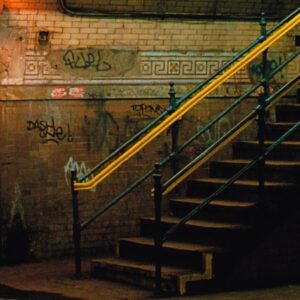
To Understand America's Fear-Driven Response to Terrorism, Look to Chicago
Laurence Ralph on "Policification," from Chicago to Guantánamo
The following is from The Torture Letters: Reckoning with Police Violence, by Laurence Ralph.
*
In the last letter I wrote to you—all the future mayors of Chicago—I offered the analogy of the torture tree. I hoped that it would help you visualize the reach of the use-of-force continuum and its often-devastating impact. My intention was to give you a more vivid sense of the terrible ways that police force shapes the lives of many Chicagoans.
I told you that the torture tree reinforces a racial caste system that subjects a disproportionate number of Black Chicagoans to injury and death. It erodes the legitimacy of the government, and hence the Office of the Mayor. And by punishing those who are already vulnerable—while ignoring habitual harassment and violence on the part of the police—it makes the city less safe.
But I’m writing now because I want you to know that the everyday ramifications of police torture do not affect only residents of your city, or even just residents of this country. The phenomenon of police torture has an impact on people all across the globe. Knowing this, I hope, will compel you to think of your responsibility as mayor in the broadest possible terms.
How, you may be wondering, is police torture in Chicago a transnational concern? To answer this question, we must reexamine the roots, which is to say, the resources that your city invests in policing. This investment is not derived solely from taxpayers, and it is not just financial—it is also psychological and political.
The roots represent the underwriting of fear. Before you take office, it is imperative that you know that your city government has rationalized the need for the torture tree by convincing the public of a lie: that society would descend into chaos without the police—that no one would be safe. This lie is what compels people to invest in fear. The investment in fear—financially, psychologically, and politically—is what allows the torture tree to grow taller and stronger, to sprout ever-more branches.
*
When I wrote you before, I referred to the torture tree’s branches as the police officers who operate as the human extensions of force. Now I would like to talk about one branch in particular, embodied by a man named Richard Zuley, whose torturous acts have extended from the precincts in your city to the detention center at Guantánamo Bay, Cuba.
Zuley joined the Chicago Police Department in 1977 and served as an officer until 2007. For most of that time he conducted his detective work on the North Side of the city. Toward the end of his career (the last 18 months of his time on the force, to be exact), Zuley even helped establish a counterterrorism training division within the Chicago Police Department. Zuley’s superiors deemed him qualified to head this division because he was also an officer in the US Navy who had been handpicked by decorated military officials to lead counter-intelligence missions abroad.
In 2002, five years before Zuley would retire from your police force, Major General Geoffrey Miller, the US Army official in charge of Guantánamo Bay, recruited him to the island. By all accounts, this was regarded as an especially difficult assignment. At the time, the administration at Guantánamo was facing a crisis; the interrogators were overwhelmed. There were only 26 interrogators on the base, compared to three hundred detainees, who came from mostly Saudi Arabia, Afghanistan, Pakistan, and Yemen.
Only four of the interrogators spoke Arabic. Two spoke Farsi. Zuley wasn’t a language expert, but one thing he had going for him was his expressed enthusiasm to work in such a difficult environment. A year after arriving at Guantánamo, Zuley took over the interrogation of a suspected terrorist that the Department of Defense had classified as a “high profile” target. His name was Mohamedou Ould Slahi.
The room became a literal black box, where the darkness would weigh on Mohamedou Ould Slahi, pressuring him to produce the kind of knowledge that would satisfy our government.
The US government brought Slahi from his home country of Mauritania to Guantánamo because they suspected him of planning terrorist attacks at Los Angeles International Airport as well as the CN Tower in Toronto. These failed terrorist plots took place a short time before the successful September 11 attacks. But after George W. Bush initiated the war on terror, the US government investigated these plots again, as they now believed them to be connected to a larger terrorist network.
Because Slahi was thought to be an active member of Al-Qaeda, which the US government blamed for 9/11, they wanted to know: was he the mastermind of other terrorist schemes? Our government wondered whether he was connected to the global network of Islamic terrorism, and they abducted Slahi from his home country to find out.
Before arriving at Guantánamo, Slahi was sent to a black site in Jordan, where he was questioned. It is common for the Central Intelligence Agency to transport terrorist suspects to countries like Jordan, which have less rigorous regulations for the humane treatment of prisoners. After refusing to confess there, Slahi was taken to Guantánamo.
To break him, the defense secretary at the time, Donald Rumsfeld, authorized the use of what the US government still blandly and euphemistically refers to as “enhanced interrogation techniques.” These methods were put into action after Rumsfeld had signed several memos in 2002 and 2003 arguing that international humanitarian laws, such as the Geneva Conventions, did not apply to the US military while overseas.
The Senate Armed Services Committee has now said that Rumsfeld also bears major responsibility for the abuses committed by US troops at another black site, Abu Ghraib, the camp where the US Army imprisoned Iraqis from 2003 to 2006, during the same time Slahi was imprisoned. That camp became infamous for photographs that US military police took while torturing Iraqi prisoners.
Rumsfeld’s “enhanced” methods resulted in a host of human rights violations, including physical and sexual abuse, rape, and sodomy. In Slahi’s case, these techniques consisted of being beaten, being subjected to deafening noise, and extreme temperatures, being deprived of food and liquids, having his sleep disrupted, having his medical care withheld, being confined in a coffin-sized box, and being repeatedly slapped.
There is more. But I’ll get to those details later. For now, I should mention that US Supreme Court decisions, including Hamdan v. Rumsfeld (2006), eventually ruled that the Geneva Conventions do, in fact, apply. But by the time that decision was handed down, it was too late to prevent Slahi’s torture, which had occurred three years before the decision.
During the period that Zuley oversaw Slahi’s interrogation, he eventually made sure Slahi experienced all the torture techniques I just described. But the relationship between the two men did not start out with torture and torment. Zuley befriended Slahi at first. Zuley seemed genuinely interested in Slahi’s hobbies and family life, and he used the information Slahi shared to threaten his family members. As if that weren’t bad enough, on August 25th, 2003, Zuley arranged to have Slahi kidnapped and taken off the island, where he experienced a mock execution at sea.
Slahi’s mock execution occurred according to a “special plan,” which outlined precisely what would happen to him during that day, and Donald Rumsfeld personally signed off on it. When it came to Rumsfeld’s authorization of Zuley’s “special plan” for Slahi, nothing was left to chance. The decision to have only four soldiers involved, for example, was carefully considered. Having too many people “in the know” could compromise the mission, and perhaps give Slahi a hint as to what would happen.
The use of German shepherds was deliberate as well. The dogs were meant to frighten him, to muffle his screams, and to heighten the sense of chaos during the kidnapping, so that Slahi could be easily transported from his cell onto a boat. In his reports Rumsfeld stated that the purpose of taking Slahi on an hours-long trip on a high-speed boat was to make him think he was being transported off the island, quickly, to a faraway place.
Once they circled back to shore and removed him from the boat, Zuley and the soldiers involved planned to take Slahi to a secluded part of Guantánamo called Camp Echo, where, according to the US Senate Armed Services report, his new cell and interrogation room was to be “modified in such a way as to reduce as much outside stimuli as possible.” The doors were sealed so they did not allow even a flicker of light. The room became a literal black box, where the darkness would weigh on Slahi, pressuring him to produce the kind of knowledge that would satisfy our government.
And the plan worked: at the end of many months of torture, Slahi did indeed confess—to crimes his interrogators had to tell him about because he had no knowledge of them. He admitted to planning to blow up the CN Tower, for example, despite never having heard of it. Asked if he was telling the truth about his confessions, Slahi answered: “I don’t care as long as you are pleased. So if you want to buy, I am selling.” Although Zuley was apparently pleased with this, the confession was so clearly the product of torture that the prosecutor at Guantánamo declined to file charges against him.
As the ACLU recounted, “The military lawyer originally assigned to prosecute the case against Mr. Slahi in the military commissions, Marine Corps Lieutenant Colonel Stuart Couch, determined that the statements wrung from Mr. Slahi during his interrogations were so tainted by torture that they couldn’t ethically be used against him.” Ultimately, Couch told his supervisors that he was morally opposed to Slahi’s treatment and refused to participate in the prosecution. This is why Slahi was never charged with or convicted of a crime.
Nevertheless, our government held Slahi at Guantánamo for 14 years. For several of those years, when he was not being interrogated and tortured, when he was alone in his cell, Slahi produced another type of knowledge based on his experience on Guantánamo Bay. He wrote a diary. That is what I want to tell you about now: Slahi’s writing. Mohamedou Ould Slahi’s diary had a great deal to do with his ultimate release. And that is almost as unimaginable as the torture he endured.
*
In 2015, Mohamedou Ould Slahi published Guantánamo Diary, the first memoir written by a suspected terrorist while still incarcerated at the detention center at Guantánamo Bay. There are many remarkable things about this book. But the most remarkable is perhaps its very existence. Slahi wrote the 466-page manuscript in English, a language he learned at Guantánamo; and the book went on to become an international best seller for its description of the intimate details of torture.
In addition to the torture that Rumsfeld approved (the “enhanced methods”), Slahi also talks about being force-fed seawater, sexually molested, and kicked and punched across the face. He endured all of this with Zuley telling him that he got permission to detain his mother on Guantánamo. If she came, Zuley said, she would likely be gang-raped.
For several years after Slahi completed the manuscript, his diary was held under lock and key in an unmarked building not far from the White House and the Pentagon.
Still, of all the days Slahi writes about in his diary, the day in which his life is threatened at sea has garnered the most attention. Media and the courts have seized on this day because in checking the veracity of his story, journalists were able to prove that powerful people in the US government, like Donald Rumsfeld, allowed Slahi’s torture to happen. They also cross-referenced the information that Slahi wrote about with the public record—this, despite the fact that the US government made the ability to check the veracity of Slahi’s claims especially difficult through its use of redaction.
I encourage you to read Guantánamo Diary. Once you do, I’m sure you’ll be struck by the black-bar redactions on almost every page, over 2,500 in total, which, despite their ubiquity, are unable to mute Slahi’s voice. For our purposes, these little black boxes represent the US government’s power to shield its personnel from responsibility for torture through an elaborate censorship process. That process occurred while Slahi was still at Guantánamo and went something like this.
Every time Slahi would finish a section of his manuscript, he would have to surrender his writing to the government for review. Every page of each section, and every word of each page, would be carefully scrutinized. Once Slahi finished writing this manuscript, the government classified it as “secret,” which, according to Slahi’s editor, is an official designation that “meant that it could cause serious damage to national security if it becomes public.”
The US government also tagged Slahi’s manuscript with the “no forn” designation, which meant that it was not to be shared with any foreign countries or foreign intelligence services.
For several years after Slahi completed the manuscript, his diary was held under lock and key in an unmarked building not far from the White House and the Pentagon. To read his manuscript someone would need full security clearance and an official explanation as to why they needed to see it. Being Slahi’s lawyer was not even sufficient reason to have access to the material—this, despite the fact that the information contained in the manuscript could have provided additional evidence that our government had little cause to justify his detention.
It would take six years for his lawyers, Nancy Hollander, Theresa Duncan, and Linda Moreno, to carry out the necessary litigation to have the diary cleared for public release.
When Slahi’s lawyers finally received the heavily redacted diary in 2011, they gave it to a well-respected writer and investigative journalist, Larry Simes, to edit. By then Mohamedou Ould Slahi was on his way to becoming a well-known public figure. Journalists had reported about his case from information they uncovered through Freedom of Information Act requests, the litigation his lawyers had filed, and Justice Department and US Senate hearings that discussed his detention.
Since the information was a part of the public record, Simes decided to introduce annotations and footnotes to Slahi’s diary that corresponded to the government’s redactions. Simes’s annotations made it easier to compare the events that Slahi wrote about with the emerging public record on torture. These annotations also made it possible, in some rare cases, to uncover the identity of military personnel involved in Slahi’s torture.
Although Zuley’s name was redacted in the body of Slahi’s text, the government officials let a separate reference to Zuley slip in the footnotes of the diary. Simes would notice this mistake and comment on it as he edited the book. Those references to Zuley would lead to reporters digging into his 40-year career as a Chicago police officer, where they discovered his history of torture.
Laurence Ralph
Laurence Ralph is a Professor of Anthropology at Princeton University, where he is the Director for the Center on Transnational Policing. Before that, he was a tenured professor at Harvard University for eight years. He is the author of Renegade Dreams: Living Through Injury in Gangland Chicago (2014) and The Torture Letters: Reckoning With Police Violence (2020), both published by University of Chicago Press. He is currently a Guggenheim Fellow, a fellow of the Radcliffe Institute for Advanced Study, and a member of the Institute for Advanced Study at Princeton; he has also been the recipient of fellowships from the Guggenheim National Science Foundation, the Carnegie Corporation, and the Ford Foundation. He lives in Princeton, New Jersey with his wife and daughter.












